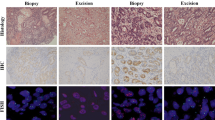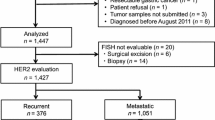Abstract
Accurate assessment of human epidermal growth factor receptor (HER) 2 is essential for efficient selection of patients who may benefit from therapies targeting this surface receptor (e.g., trastuzumab). Intratumoral heterogeneity of HER2 expression may potentially contribute to inaccurate assessment of HER2 status. To clarify intratumoral heterogeneity of HER2 expression and its potential clinical impact on assessment of HER2 status, we analyzed 148 endoscopic biopsy specimens and 117 excisional tumor specimens collected from 148 patients with primary gastric cancer. Specifically, we assessed HER2 protein overexpression and gene amplification using, respectively, immunohistochemistry (IHC) and fluorescence in situ hybridization (FISH). There were 28 IHC-positive cases and 25 FISH-positive cases among these 148 patients. Heterogeneous HER2 protein expression was demonstrated in 23 of 29 (79.3%) IHC-positive cases, while gene expression heterogeneity was found in 11 of 25 (44.0%) FISH-positive cases. Intratumoral heterogeneity was the main reason of discordant results between IHC and FISH or between endoscopic biopsy and excisional tumor specimens. The clinical significance and impact of intratumoral HER2 expression heterogeneity on treatment outcome in gastric cancer require further studies.

Similar content being viewed by others
References
Kelley, J. R., & Duggan, J. M. (2003). Gastric cancer epidemiology and risk factors. Journal of Clinical Epidemiology, 56, 1–9.
Roder DM (2002) The epidemiology of gastric cancer. Gastric Cancer. 5 Suppl 1, 5–11.
Comella, P., Franco, L., Casaretti, R., de Portu, S., & Menditto, E. (2009). Emerging role of capecitabine in gastric cancer. Pharmacotherapy, 29, 318–330.
Gravalos, C., & Jimeno, A. (2008). HER2 in gastric cancer: a new prognostic factor and a novel therapeutic target. Annals of Oncology, 19, 1523–1529.
Wagner, A. D., Grothe, W., Haerting, J., Kleber, G., Grothey, A., & Fleig, W. E. (2006). Chemotherapy in advanced gastric cancer: A systematic review and meta-analysis based on aggregate data. Journal of Clinical Oncology, 24, 2903–2909.
Cunningham, D., Allum, W. H., Stenning, S. P., Thompson, J. N., Van de Velde, C. J., Nicolson, M., et al. (2006). Perioperative chemotherapy versus surgery alone for resectable gastroesophageal cancer. New England Journal of Medicine, 355, 11–20.
Ohtsu, A. (2008). Chemotherapy for metastatic gastric cancer: past, present, and future. Journal of Gastroenterology, 43, 256–264.
Jorgensen, J. T. (2010). Targeted HER2 treatment in advanced gastric cancer. Oncology, 78, 26–33.
Cunningham, S. C., Kamangar, F., Kim, M. P., Hammoud, S., Haque, R., Maitra, A., et al. (2005). Survival after gastric adenocarcinoma resection: eighteen-year experience at a single institution. Journal of Gastrointestinal Surgery, 9, 718–725.
Akiyama, T., Sudo, C., Ogawara, H., Toyoshima, K., & Yamamoto, T. (1986). The product of the human c-erbB-2 gene: A 185-kilodalton glycoprotein with tyrosine kinase activity. Science, 232, 1644–1646.
Normanno, N., Bianco, C., Strizzi, L., Mancino, M., Maiello, M. R., De, L. A., et al. (2005). The ErbB receptors and their ligands in cancer: an overview. Current Drug Targets, 6, 243–257.
Hynes, N. E., & Lane, H. A. (2005). ERBB receptors and cancer: The complexity of targeted inhibitors. Nature Reviews Cancer, 5, 341–354.
Hudis, C. A. (2007). Trastuzumab: Mechanism of action and use in clinical practice. New England Journal of Medicine, 357, 39–51.
Smith, I., Procter, M., Gelber, R. D., Guillaume, S., Feyereislova, A., Dowsett, M., et al. (2007). 2-year follow-up of trastuzumab after adjuvant chemotherapy in HER2-positive breast cancer: a randomised controlled trial. Lancet, 369, 29–36.
Slamon, D. J., Leyland-Jones, B., Shak, S., Fuchs, H., Paton, V., Bajamonde, A., et al. (2001). Use of chemotherapy plus a monoclonal antibody against HER2 for metastatic breast cancer that overexpresses HER2. New England Journal of Medicine, 344, 783–792.
Bang, Y. J., Van, C. E., Feyereislova, A., Chung, H. C., Shen, L., Sawaki, A., et al. (2010). Trastuzumab in combination with chemotherapy versus chemotherapy alone for treatment of HER2-positive advanced gastric or gastro-oesophageal junction cancer (ToGA): A phase 3, open-label, randomised controlled trial. Lancet, 376, 687–697.
Croxtall, J. D., & McKeage, K. (2010). Trastuzumab: In HER2-positive metastatic gastric cancer. Drugs, 70, 2259–2267.
Sui, W., Ou, M., Chen, J., Wan, Y., Peng, H., Qi, M., et al. (2009). Comparison of immunohistochemistry (IHC) and fluorescence in situ hybridization (FISH) assessment for HER2 status in breast cancer. World Journal of Surgical Oncology, 7, 83.
Rüschoff, J., Dietel, M., Baretton, G., Arbogast, S., Walch, A., Monges, G., et al. (2010). HER2 diagnostics in gastric cancer-guideline validation and development of standardized immunohistochemical testing. Virchows Archiv, 457, 299–307.
Vanden Bempt, I., Vanhentenrijk, V., Drijkoningen, M., Wlodarska, I., Vandenberghe, P., & De Wolf-Peeters, C. (2005). Real-time reverse transcription-PCR and fluorescence in situ hybridization are complementary to understand the mechanisms involved in HER2/neu overexpression in human breast carcinomas. Histopathology, 46, 431–441.
Bartlett, J. M., & Forsyth, A. (2006). Detection of HER2 gene amplification by fluorescence in situ hybridization in breast cancer. Methods in Molecular Medicine, 120, 309–322.
Sauter, G., Lee, J., Bartlett, J. M., Slamon, D. J., & Press, M. F. (2009). Guidelines for human epidermal growth factor receptor 2 testing: Biologic and methodologic considerations. Journal of Clinical Oncology, 27, 1323–1333.
Wolff, A. C., Hammond, M. E., Schwartz, J. N., Hagerty, K. L., Allred, D. C., Cote, R. J., et al. (2007). American Society of Clinical Oncology/College of American Pathologists guideline recommendations for human epidermal growth factor receptor 2 testing in breast cancer. Journal of Clinical Oncology, 25, 118–145.
Hofmann, M., Stoss, O., Shi, D., Buttner, R., van de Vijver, M., Kim, W., et al. (2008). Assessment of a HER2 scoring system for gastric cancer: Results from a validation study. Histopathology, 52, 797–805.
Brunelli, M., Manfrin, E., Martignoni, G., Miller, K., Remo, A., Reghellin, D., et al. (2009). Genotypic intratumoral heterogeneity in breast carcinoma with HER2/neu amplification: Evaluation according to ASCO/CAP criteria. American Journal of Clinical Pathology, 131, 678–682.
Fukushige, S., Matsubara, K., Yoshida, M., Sasaki, M., Suzuki, T., Semba, K., et al. (1986). Localization of a novel v-erbB-related gene, c-erbB-2, on human chromosome 17 and its amplification in a gastric cancer cell line. Molecular and Cellular Biology, 6, 955–958.
Takehana, T., Kunitomo, K., Kono, K., Kitahara, F., Iizuka, H., Matsumoto, Y., et al. (2002). Status of c-erbB-2 in gastric adenocarcinoma: A comparative study of immunohistochemistry, fluorescence in situ hybridization and enzyme-linked immuno-sorbent assay. International Journal of Cancer, 98, 833–837.
Allgayer, H., Babic, R., Gruetzner, K. U., Tarabichi, A., Schildberg, F. W., & Heiss, M. M. (2000). c-erbB-2 is of independent prognostic relevance in gastric cancer and is associated with the expression of tumor-associated protease systems. Journal of Clinical Oncology, 18, 2201–2209.
Wang, Y. L., Sheu, B. S., Yang, H. B., Lin, P. W., & Chang, Y. C. (2002). Overexpression of c-erb-B2 proteins in tumor and non-tumor parts of gastric adenocarcinoma–emphasis on its relation to H. pylori infection and clinicohistological characteristics. Hepato-Gastroenterology, 49, 1172–1176.
Shun, C. T., Wu, M. S., Lin, J. T., Chen, S. Y., Wang, H. P., Lee, W. J., et al. (1997). Relationship of p53 and c-erbB-2 expression to histopathological features, Helicobacter pylori infection and prognosis in gastric cancer. Hepato-Gastroenterology, 44, 604–609.
Yano, T., Doi, T., Ohtsu, A., Boku, N., Hashizume, K., Nakanishi, M., et al. (2006). Comparison of HER2 gene amplification assessed by fluorescence in situ hybridization and HER2 protein expression assessed by immunohistochemistry in gastric cancer. Oncology Reports, 15, 65–71.
Kim, M. A., Jung, E. J., Lee, H. S., Lee, H. E., Jeon, Y. K., Yang, H. K., et al. (2007). Evaluation of HER2 gene status in gastric carcinoma using immunohistochemistry, fluorescence in situ hybridization, and real-time quantitative polymerase chain reaction. Human Pathology, 38, 1386–1393.
Yan, B., Yau, E. X., Bte Omar, S. S., Ong, C. W., Pang, B., Yeoh, K. G., et al. (2010). A study of HER2 gene amplification and protein expression in gastric cancer. Journal of Clinical Pathology, 63, 839–842.
Barros-Silva, J. D., Leitao, D., Afonso, L., Vieira, J., Dinis-Ribeiro, M., Fragoso, M., et al. (2009). Association of ERBB2 gene status with histopathological parameters and disease-specific survival in gastric carcinoma patients. British Journal of Cancer, 100, 487–493.
Bang, Y., Chung, J., Xu, J., et al. (2009). Pathological features of advanced gastric cancer (gc): Relationship to human epidermal growth factor receptor 2 (HER2) positivity in the global screening programme of the ToGA trail. Journal of Clinical Oncology 27, abstract 4556.
Vance, G. H., Barry, T. S., Bloom, K. J., Fitzgibbons, P. L., Hicks, D. G., Jenkins, R. B., et al. (2009). Genetic heterogeneity in HER2 testing in breast cancer: panel summary and guidelines. Archives of Pathology and Laboratory Medicine, 133, 611–612.
Marx, A. H., Tharun, L., Muth, J., Dancau, A. M., Simon, R., Yekebas, E., et al. (2009). HER2 amplification is highly homogenous in gastric cancer. Human Pathology, 40, 769–777.
Bilous, M., Osamura, R. Y., Ruschoff, J., van de Vijver, M., Hanna, W., Penault-Llorca, F., et al. (2010). HER2 amplification is highly homogenous in gastric cancer. Human Pathology, 41, 304–305.
Grabsch, H., Sivakumar, S., Gray, S., Gabbert, H. E., & Muller, W. (2010). HER2 expression in gastric cancer: Rare, heterogeneous and of no prognostic value—conclusions from 924 cases of two independent series. Cell Oncol., 32, 57–65.
Author information
Authors and Affiliations
Corresponding authors
Rights and permissions
About this article
Cite this article
Yang, J., Luo, H., Li, Y. et al. Intratumoral Heterogeneity Determines Discordant Results of Diagnostic Tests for Human Epidermal Growth Factor Receptor (HER) 2 in Gastric Cancer Specimens. Cell Biochem Biophys 62, 221–228 (2012). https://doi.org/10.1007/s12013-011-9286-1
Published:
Issue Date:
DOI: https://doi.org/10.1007/s12013-011-9286-1




